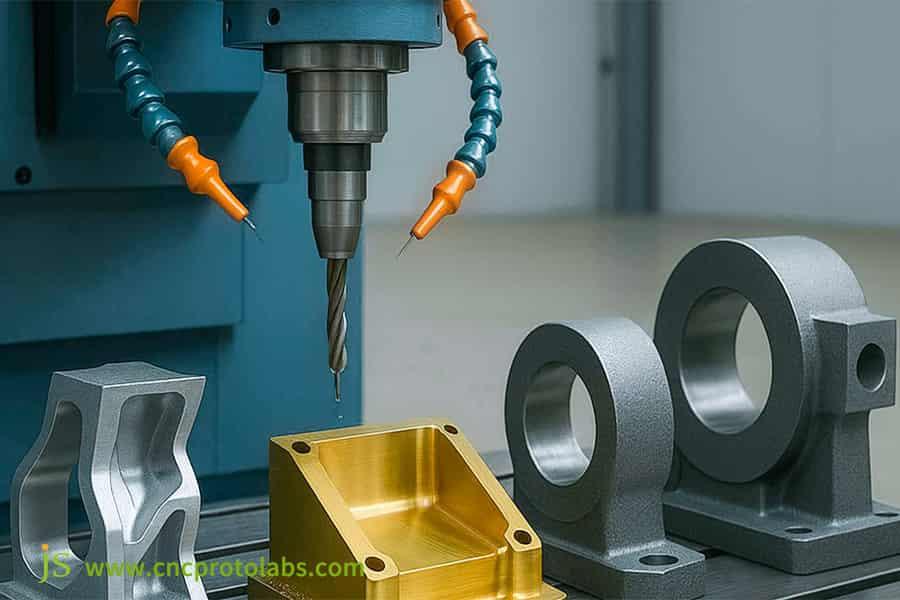You will be holding in your hand a fully working prototype in a matter of days: one side is cold aluminum alloy, precision-machined to create heat sink fins and a structural frame, the other side is hard engineering plastic, molded into an ergonomically contoured housing, there is even a soft silicone seal inside.
This entire multi-material assembly is not created on several production lines, but on one CNC machining center in one setup or lean process. This is the capability of today's rapid prototype manufacturing.
This guide will explore how CNC rapid prototyping technology leverages metal, plastic, and composite materials to effortlessly develop multi-material prototypes, dramatically streamlining your product innovation cycle.
Key Answer Summary
| Comparison Dimensions | Single-Material CNC Prototype | Multi-Material Hybrid CNC Prototype |
| Core Concept | Focus on achieving optimal cutting results for a single material. | Integrated design thinking seamlessly combines the performance advantages of different materials during the prototyping phase. |
| Technical Focus | Optimize cutting parameters and tool selection for a single material. | Develop cross-material processing strategies, address differences in thermal expansion coefficients, and ensure interface accuracy. |
| Process Flow | Relatively linear: CAD -> CAM -> Fixture -> Processing. | Highly Collaborative: Multi-material CAD assembly design -> Customized fixture design -> Sequential processing parameters -> In-situ or secondary fixture integration. |
| Key Advantages | Fast speed, realistic material properties, and high surface quality. | Highly functional: Prototypes can achieve all the functions of the final product (structure, heat dissipation, insulation, and sealing). Comprehensive Verification: Compatibility and interference between different materials can be tested simultaneously. |
| Typical Applications | Single-function components such as structural parts, housings, and gears. | Robotic joints (metal structure + plastic housing), medical handles (metal core + biocompatible plastic), and smart devices (metal frame + antenna plastic). |
How To Achieve Multi-Material Prototyping? JS Precision CNC Machining Solutions
JS Precision has over 15 years of practical experience in multi-material rapid prototyping and has finished multi-material prototype projects for over 500 clients across 12 industries, including aerospace, medical, and consumer electronics.
For example, we prototyped a titanium alloy and PEEK composite sensor housing for an aerospace client, reducing delivery time to just four days while maintaining dimensional accuracy of ±0.005mm.
In completing a prototype of a stainless steel and medical silicone catheter connector for a medical client, we achieved 30% improvement in tensile strength through the utilization of a physical interlocking structure. We even prototyped a client in consumer electronics, an integrated PC plastic and aluminum alloy housing, both aesthetically and for structural strength.
The experience covers over 10 material combinations and involves key technologies such as five-axis CNC and adaptive parameter adjustment. This guide is compiled from over a thousand rapid prototype development projects, and each item is tried and tested.
JS Precision, through its profound multi-material CNC machining experience, can provide customized solutions for your rapid prototype development project. Simply forward your design drawings to us, and we will immediately review and provide process recommendations to execute your project effectively.
The Engine Of Rapid Prototype Development: Overcoming CNC's Core Challenges
To enable high-quality multi-material rapid prototyping, we must first address the basic challenges of CNC machining—those that are due to differences in material properties and process complexity. Only by overcoming these challenges can we ensure the efficiency and precision of rapid prototype development.
Challenge 1: Design Integration
Traditional prototypes are typically developed in separate components, which easily leads to accuracy issues in later assembly. Multi-material prototyping requires designers to consider the joining and fixturing of materials from the start. For example, when metal and plastic are being joined, physical interlocking features must be pre-designed to prevent weak joining later.
Challenge 2: Manufacturing Serialization
The foundation of manufacturing serialization is processing order planning and fixture design. Which is to be machined first, hard or soft material? How can the fixture securely clamp workpieces of different materials? Failure to solve these issues results in machining defects. Machining the soft material first, for example, is easily affected by the vibration of the subsequent hard material machining.
Challenge 3: Material "Dialogue"
Different materials possess considerably different cutting forces, thermal expansion coefficients, and stiffness. When machining aluminum (metal) and ABS plastic, for example, aluminum requires high speed and low feeds, while ABS requires low speed and high feeds.
The use of the same parameters for all parts can easily lead to part distortion or dimensional errors, influencing the rapid prototyping manufacturing quality.
Challenge 4: Efficiency vs. Cost Trade-off
Multi-material machining requires more complex process planning and extra setups, which increases the processing time and cost. Sustaining quality while addressing the basic speed requirements of rapid prototyping is a challenge that must be overcome by businesses.
Mastering Rapid Prototype Manufacturing: Key Technologies In CNC Machining
After overcoming the basic challenges of CNC machining multi-material prototypes, mastering key technologies is the key to advancing rapid prototyping manufacturing. These technologies enhance quality and efficiency in three areas:
Advanced CAM Software and Simulation
Through the use of CAM software with the capacity to assist multi-axis machining and "machining sequence" planning, such as Mastercam, one can accurately plan multi-material machining processes. Meanwhile, cutting simulation in a virtual environment can foresee tool-fixture interference issues in advance, avoiding errors in real machining and conserving material waste.
Adaptive Machining Strategies
1. "Single-Setup" Technology: Pre-clamping of different materials in precision fixtures. All materials are machined in a single setup with program control, which gives very good relative position accuracy and eliminates multiple setup errors.
2. Sequential Parameter Recall: CAM software is capable of recalling different cutting parameter libraries automatically, i.e., high speed and slow feed rates for metal machining and instantaneous change to low speed and fast feed rates for plastics. The optimum tool is chosen automatically, and no continuous manual adjustment is required.
Intelligent Fixture Design
With the modular, configurable fixture systems, e.g., dedicated fixtures or millable vise blocks, it can be tailored to a variety of irregular-shaped blanks. Not only is the mounting of the fixture convenient, but it also stabilizes machining for workpieces with various materials, improving the accuracy of rapid prototype machining.
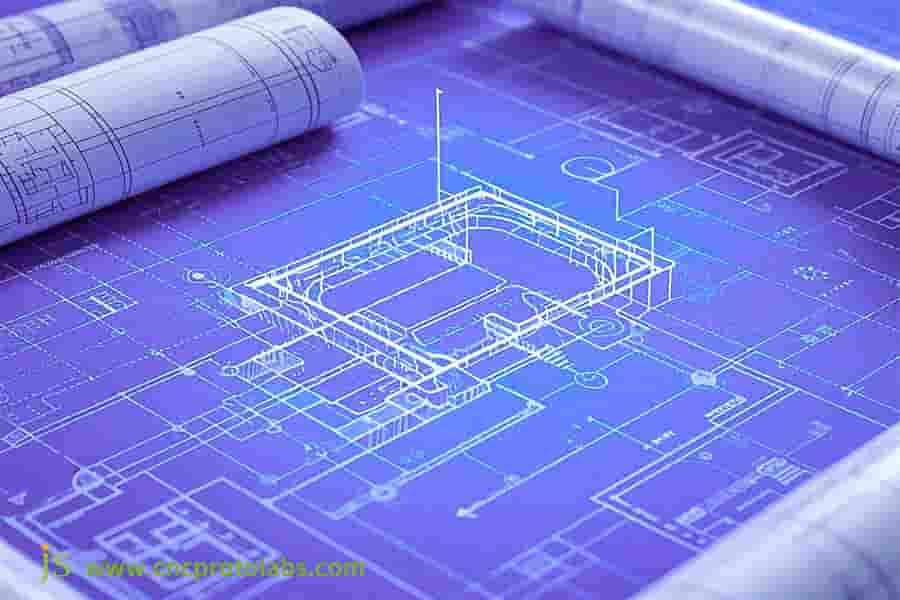
Figure 1: CNC rapid prototyping
The Precision Of Rapid Prototype Machining: Overcoming Composite Materials
In multi-material rapid prototyping, the machining precision of compound materials (carbon fiber compound and glass fiber compound) has direct impacts on overall rapid prototype machining quality. Their individual natures bring respective challenges, which need custom-made CNC solutions.
Compound Material Challenges and CNC Solutions Comparison
| Compound Material Type | Major Challenge | CNC Solution |
| Carbon Fiber Reinforced Plastic (CFRP) | Anisotropic and interlaminar tearing prone. | 1. Use diamond-coated or polycrystalline diamond tools. 2. Adopt a high speed (12,000 rpm), low depth of cut (0.1 mm), and high feed rate approach, 3. Use a powerful vacuum cleaner. |
| Glass Fiber Reinforced Plastic (GFRP) | Highly abrasive with excessive tool wear. | 1. Use polycrystalline diamond tools. 2. Use a "shearing" machining approach with high speed, low depth of cut, and high feed rate. 3. Use dry cutting or minimum quantity lubrication. |
More CNC Solutions
Optimization of process parameters by careful tuning is essential. Machining the fibers by "shearing" rather than "pulling" gives perfect edges, without delamination and burrs. Powerful vacuum cleaner can vacuum cut dust directly, protecting equipment and worker's health and preventing dust from affecting machining accuracy and ensuring smooth rapid prototype manufacturing.
JS Precision is proficient in CNC rapid prototyping technology of composite material, completely solving tearing and tool wear issues in composite machining, ensuring high-precision rapid prototype machining and meeting your functional testing requirements.
Overcoming The Challenges Of Rapid Prototyping Metal And Plastic
Metal and plastic is a most popular multi-material rapid prototyping pair. But their physical property differences (such as thermal conductivity and hardness) bring forth huge processing challenges. It is only with the overcoming of these challenges that metal and plastic rapid prototyping prototype quality can be guaranteed.
Heat control is a big problem. Machining heat of the metal is transferred to and softens the plastic in the area. The solution is to use skip machining: machining the metal part for a while before moving to the plastic part or another area to allow the metal area to cool. Local cooling, i.e., air cooling, is also used to prevent plastic heat deformation.
Interface stress and precision are also of the utmost importance. How do we have a seamless interface between plastic and metal parts?
The solution is to use the precision machining capabilities of custom CNC rapid prototyping service providers such as JS Precision to directly machine microstructures (e.g., undercuts and ribs) for press-fit, snap-fit, or bonding, achieving physical interlocking and enhancing joint strength and sealing.
To transcend rapid prototyping metal and plastic machining challenges, JS Precision offers innovative thermal management and interface machining solutions to ensure the precision and longevity of the bond between the two materials for your prototypes' stable performance.
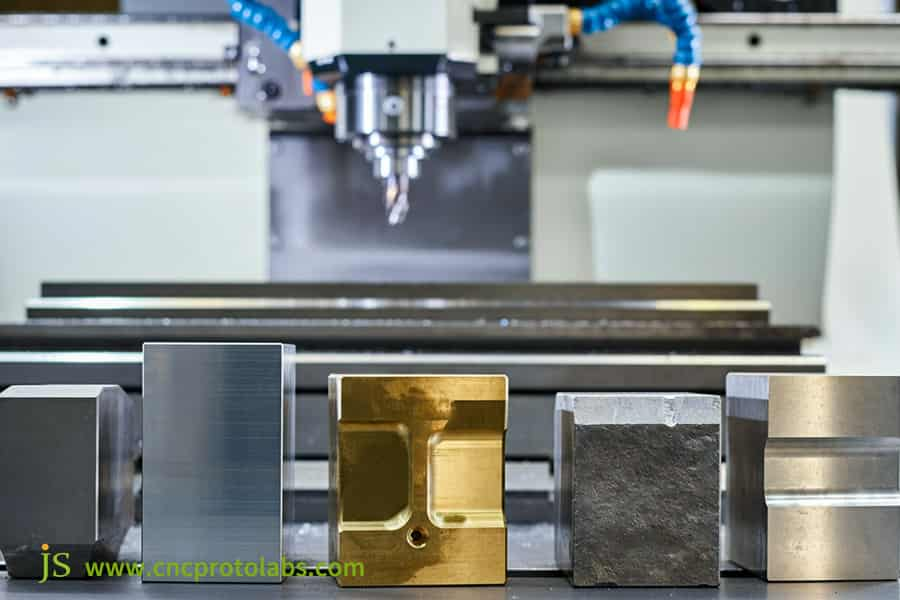
Figure 2: rapid prototyping metal
Strategies For Custom CNC Rapid Prototyping Of Hard And Soft Materials
The combination of hard material (e.g., stainless steel and aluminum alloy) and soft material (e.g., soft plastics and silicone) is common in custom prototyping. Good quality custom CNC rapid prototyping can be achieved by implementing a scientific machining approach that balances the machining requirements of different materials.
Machining Principles and Parameter Adjustment
| Material Type | Machining Principles | Tool Selection | Machining Parameters |
| Hard Materials | Hard Materials First, Soft Materials Second (To Avoid Impact from the Hard Material). | Sharp and Wear-Resistant Tools, e.g., Carbide Tools. | High Speed, Medium Feed Rate, and Large Depth of Cut. |
| Soft Materials | Machining Later (To Avoid Impact from the Hard Material). | Tools with Special Geometry and Coatings for Built-Up Edge Prevention. | Very High Speed, High Feed Rate, and Small Depth of Cut. |
Machining the hard material first because the process is more stable with less vibration and deflection being generated. Then, using the machined hard material as a reference for machining the soft material increases overall accuracy.
The selection of cutting tools should balance sharpness and the ability to prevent chip buildup. Dynamic parameter adjustment prevents soft material melting or deformation due to overheating, ensuring quality in custom CNC rapid prototyping.
JS Precision has custom CNC rapid prototyping specialized service and can develop customized machining techniques based on the characteristics of hard and soft solids to ensure prototype quality and precisely fit your custom requirements.
CNC vs. 3D Printing: A Showdown In Multi-Material Prototype Production
CNC machining and 3D printing are the most sought-after technologies for multi-material prototyping. They both have their merits, and the use of either of them depends on your rapid prototype development needs. The difference between them can help you make the right choice.
Comparison of the Merits of CNC and 3D Printing Multi-Material Prototyping
| Comparison Dimensions | Merits of CNC Rapid Prototyping | Merits of 3D Printing Multi-Material Prototyping |
| Material Authenticity | Since the same metal alloys and engineering plastics are utilized as in end production, performance testing data is reliable. | Material selection is relatively limited, and some material characteristics may differ from those of production materials in bulk. |
| Surface Quality and Precision | Typically results in smoother surfaces and improved dimensional accuracy (±0.005mm). | Surfaces are prone to layering, and accuracy is relatively low (±0.1mm). |
| Strength and Durability | Machined parts are dense solid mechanical parts with mechanical properties far superior to those of most 3D-printed parts. | Parts are mostly layered, which results in poor mechanical properties. |
| Geometric Freedom | Complex internal flow channels and lattice structures are of great processing complexity. | Complex internal flow channels and lattice structures are of great processing complexity. |
| Tooling Requirements | Special fixtures are required. | No fixtures are required. |
Conclusion: CNC rapid prototyping is more suitable for creating high-precision, high-strength, functional-testing-level prototypes, meeting the high performance requirements of rapid prototyping development. 3D printing is, nevertheless, more suitable for proof-of-concept, form-fitting, and prototypes with complex internal cavities.
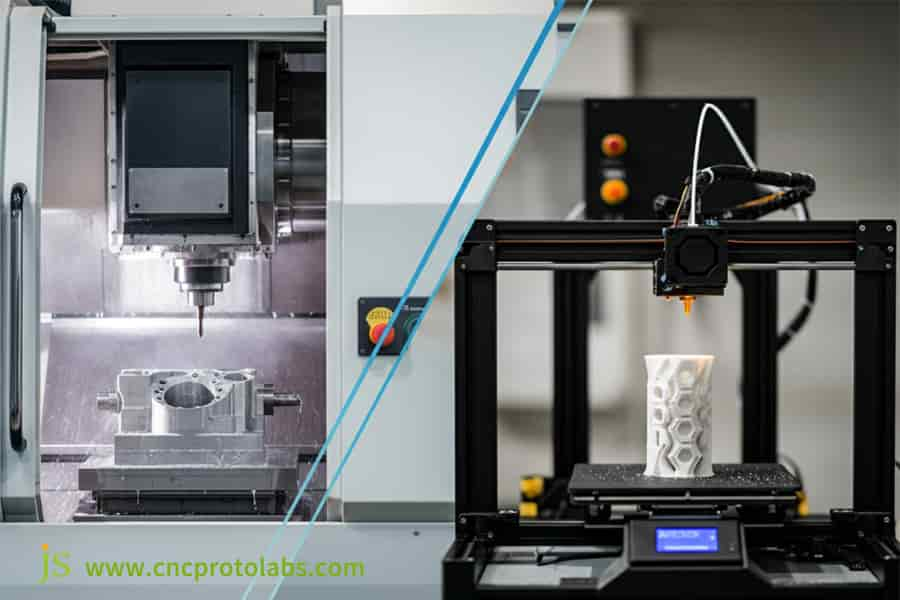
Figure 3: Multi-material CNC machining prototype (left) VS. 3D printing part (right).
Case Study: How JS Precision Made An Integrated Multi-Material Propulsion Prototype For A Drone
This example provides a clearer intuition of how CNC machining addresses the issues of multi-material rapid prototyping development. Next, we will describe the entire process JS Precision followed to create a multi-material propulsion prototype for a client in the drone industry.
Client Requirements
A drone company required a lightweight, high-thrust propulsion prototype for flight testing.
High strength and high-coaxial integration of carbon fiber composite blades and aluminum alloy hubs were the requirements. The blade needed to keep its weight below 20g, the hub needed to be resistant to 10,000 rpm and light, and the interface of the two needed to keep ±0.003mm precision.
The most salient challenges were CFRP blade tear-resistant machining, high-strength and light structure designing for the aluminum hub, and micron-level precision at the interface of the two.
JS Precision's Solution
1.Collaborative Design: Our engineers worked with the customer to enhance connection design, incorporating a mortise and tenon joint structure instead of simply bonding. The structure gives a 35% increase in joint strength and simplifies machining and assembly.
2.Serialized Machining:
- All CFRP blades were first machined precisely in one go by a five-axis CNC machine using diamond-coated cutting tools at a high speed of 12,000 rpm and a very small depth of cut of 0.1 mm with no delamination on the edges.
- In the second example, in the same assembly, the blade center was pre-processed with a high-precision mortise joint structure by carbide cutting tools.
- Third, the pre-processing aluminum alloy wheel blank was installed in a precision jig, and a hollowed-out structure (20% weight reduction) was used to process the mortise joint head with an interference fit with the mortise joint.
3.Integration and Verification: Using a high-temperature-resistant adhesive and physical interlocking design, the two parts were press-fitted together to form the completed propeller. The key dimensions were then checked using a coordinate measuring machine to ensure compliance.
Results
The customer had a working prototype ready for flight and high-speed wind tunnel testing within 5 days, validating the design and reducing the product development cycle by 70%.
The prototype performed with the expected thrust and was stable during testing, securing the investment necessary and enabling the customer to take their rapid prototype development project to the next stage successfully.
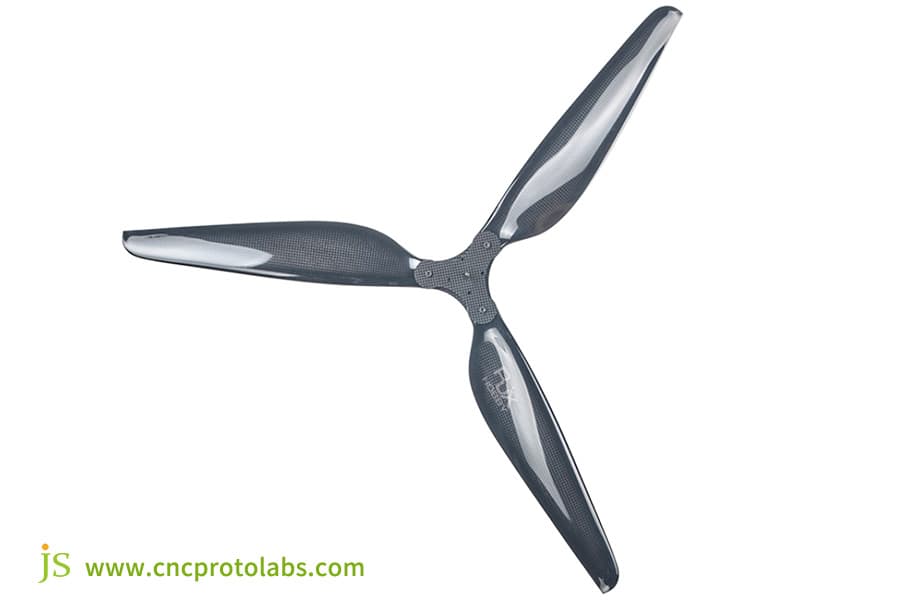
Figure 4: The carbon fiber and aluminum alloy folding propeller is manufactured using 5-axis CNC machining
Initiate Your Project: Engaging A Professional CNC Rapid Prototyping Service
You should select a professional CNC rapid prototyping service provider for a hassle-free multi-material CNC prototype development.
Evaluate their technical breadth: Find out if the service provider has the know-how and equipment to handle all the materials in your project, from rapid prototyping metals to special plastics. For example, can the service provider handle special materials like PEEK and ceramic-filled composites, and is five-axis CNC equipment available for handling complex structures.
Explore engineering support capabilities: A capable service provider would provide design for manufacturability reviews, rather than simply accepting drawings passively. They are able to proactively flag manufacturability issues in the design and provide optimization recommendations, saving you late-stage modification costs and rapid prototyping manufacturing efficiency.
Quality system review: The service provider should be asked how they control key dimensions of multi-material prototypes, especially the accuracy of interface fits. Whether they have test equipment such as coordinate measuring machines and a thorough test procedure or not has a direct influence on prototype quality.
Guide the quote process: A modern service platform should have a smooth online quote process and articulate process issues and cost structures clearly. Fast and fixed quotes enable you to plan your project budget on time and minimize project initiation time.
JS Precision is a full technical capability, professional engineer supported, full quality assurance system CNC rapid prototyping service. Our fast quoting process allows you to get your project started effectively, confidently, and speedily.
FAQs
Q1: Is CNC machining multi-material prototypes much slower than 3D printing?
Not always. For complex-structure but low-strength-required prototypes, 3D printing could be quicker. For highly accurate functional prototypes with good surface finish and realistic material properties needs, CNC usually possesses time-to-first-part availability advantages. This is due to the fact that it does indeed save time on the laborious processes after 3D printing, including support removal, sanding, and post-curing, and is more in line with the efficiency requirements of rapid prototype development.
Q2: Is multi-material CNC prototyping very expensive?
Multi-material machining is more expensive due to its complexity, but value vastly outweighs incremental cost. Through one-time rapid prototyping manufacturing, you can presolve materials compatibility issues, assembly interferences, and performance bottlenecks, and avoid changes that would be tens or even hundreds of times more expensive in production volume.
Q3: How quickly can I get a multi-material CNC prototype?
At JS Precision, under our normal rapid prototype machining process, from your qualified data receiving to shipping, simple multi-material prototypes can be completed in 2-3 working days, and complicated ones only require 5-7 working days. In this manner, we can meet your rapid prototype development schedule on time without delaying your development cycle.
Q4: What are some exotic material combinations that you can machine?
Apart from standard metals and plastics, we have also machined successfully PEEK and titanium alloy combinations, ceramic-filled composite and aluminum alloy, and ULTEM and copper alloy combinations. Our engineers are highly experienced in custom CNC rapid prototyping. Give us a call to discuss your specific needs and develop an efficient machining solution.
Summary
CNC machining has long been beyond the stereotype of "cutting metal" and is taking rapid prototyping to new heights with its unmatched flexibility and precision.
By combining the top performance of a variety of materials, it allows you to touch and confirm a nearly finished product experience at the start of product development, reducing research and development risks and accelerates time to market.
JS Precision is your perfect option if you're creating an innovative product and are looking for a manufacturing partner who is accustomed to your complex designs and can produce them with high accuracy.
With our extensive experience, state-of-the-art technology, and efficient processes, we ensure quality execution of your rapid prototype development projects to allow you to get your products to market on time.
Disclaimer
The contents of this page are for informational purposes only.JS Precision Services,there are no representations or warranties, express or implied, as to the accuracy, completeness or validity of the information. It should not be inferred that a third-party supplier or manufacturer will provide performance parameters, geometric tolerances, specific design characteristics, material quality and type or workmanship through the JS Precision Network. It's the buyer's responsibility Require parts quotation Identify specific requirements for these sections.Please contact us for more information.
JS Precision Team
JS Precision is an industry-leading company, focus on custom manufacturing solutions. We have over 20 years of experience with over 5,000 customers, and we focus on high precisionCNC machining,Sheet metal manufacturing,3D printing,Injection molding,Metal stamping,and other one-stop manufacturing services.
Our factory is equipped with over 100 state-of-the-art 5-axis machining centers, ISO 9001:2015 certified. We provide fast, efficient and high-quality manufacturing solutions to customers in more than 150 countries around the world. Whether it is small volume production or large-scale customization, we can meet your needs with the fastest delivery within 24 hours. Choose JS Precision this means selection efficiency, quality and professionalism.
To learn more, visit our website:www.cncprotolabs.com


